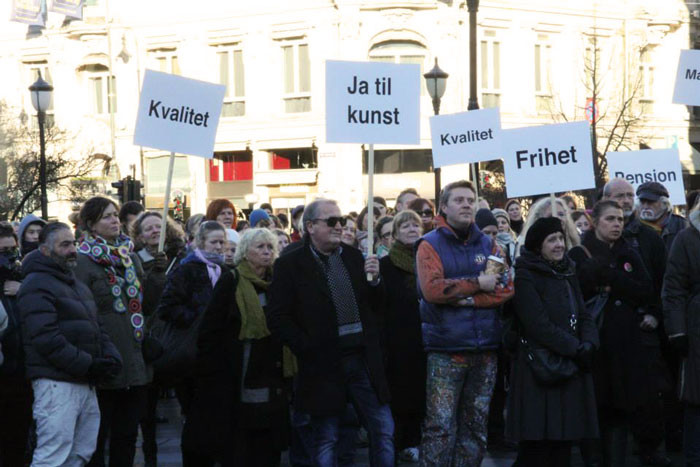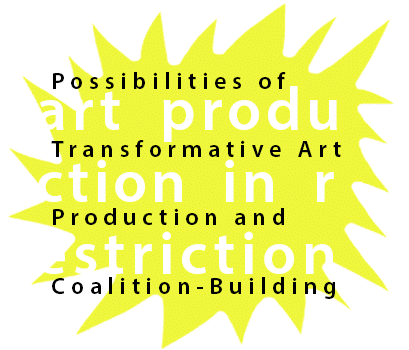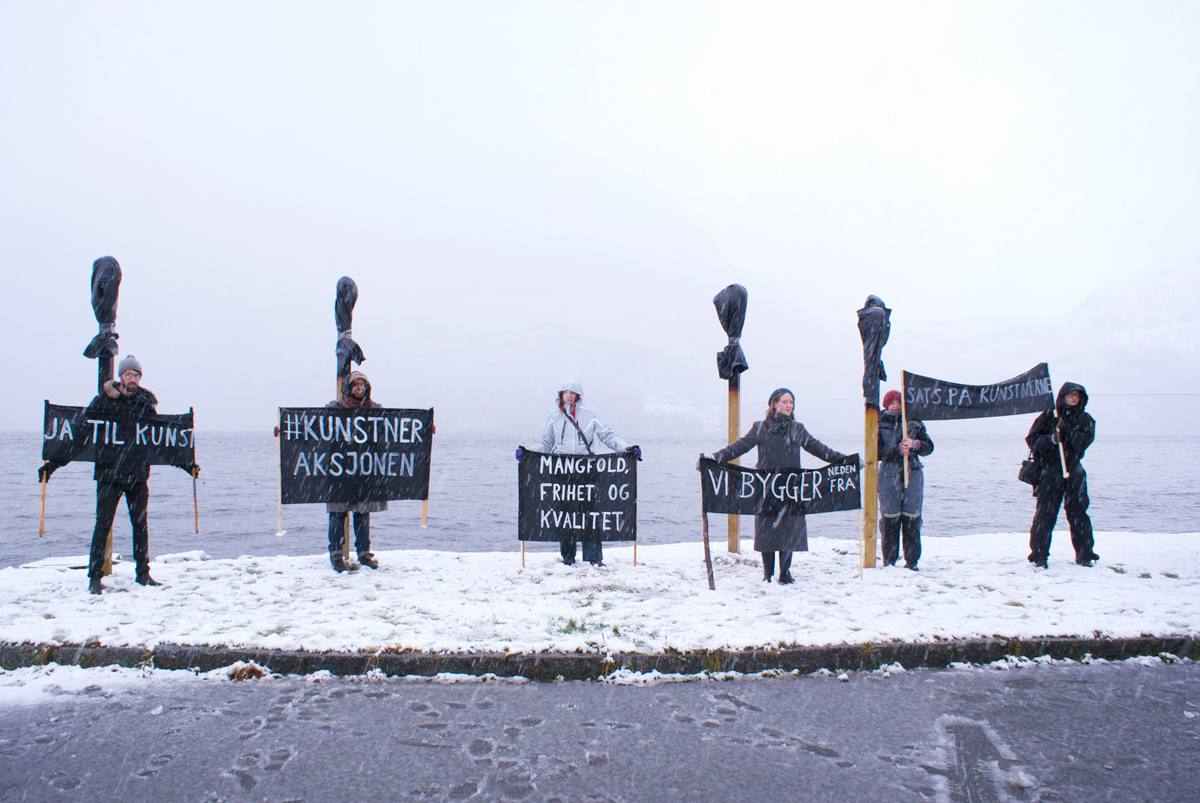When working with art, you are not doing it for the money. But all people need to eat.
Most people would presume that if an artist is having a lot of solo shows with established institutions and is participating in group shows during the year, it would secure her or him an acceptable economical situation. But if you work for the common good, outside the market – it actually could put you in a disadvantaged situation.
What the art institutions expect from the exhibiting artists for the little pay they are willing to provide, is hideous. Sometimes it is expected that the artists put up the show themselves – often working for two weeks without payment. Regardless of how long the show will last, how big the space, or how many works are shown – the payment has not been regulated for more than 20 years: it does not provide the actual costs.
As an artist without a gallery representing you, it is exhausting and almost impossible to negotiate, because you have no backup. Neither the regional nor the national artists’ association can actually help you out of the situation as it is today. For many artists a solo-show without commercial potential could put you in debt and lead to an intolerable situation. Besides the inbuilt humiliation within such a system: Why does the exhibition guard, the cleaner, the director get paid by the public to facilitate the space for art exhibitions, while the actual producers are left in debt? How should the artist survive?
This is a widely recognized number-1-issue for artists’ organisations at the moment: What could be done for the art practitioners to get paid for their ideas, working hours and the display of their art work? We have to change a system based on the idea that you don’t need to pay the artist: Exposure is payment enough and will provide future gain.
Should we cooperate with the art institutions instead of “waging a war against them”? We are dependent upon each other, and they need to understand the absurd fact that the institutions get public funding, but do not pay the artists, who actually produce what they live off. The solidarity among artists is not strong, so a general strike is not a possibility. The art world is built on a strong hierarchical order, which makes artists compete against each other on a subtle level.
The Hierarchical Order
Another aspect is the public opinion. We must change the way art practitioners are regarded: to be an artist is a job! It is a job with a lot of work, without regulated working hours and no social security. This within a society were everyone else are secured as workers. Artistic work is part of the economic system, but needs to be understood on cultural and philosophical level as well. It is an ongoing task to make the public regard artistic work as important and a basis for democracy. Artists’ voices – which are mirroring different life experiences and conditions – give different perspectives to the world and our lives, which makes art and culture deeply necessary.
In Norway, art has been seen as “high culture” for the establishment. Culture was created from Oslo. This has left the arts being seen as suspicious practice in popular believes. But this can be changed. If the funding is redistributed directly to the producers, the culture of the society the art practitioners operate in can become more open and innovative – creativity and art become a part of the society’s identity. Even though art itself cannot be planned and structured by the state, the notion that funding independent and non-market art has a broader impact on society is crucial. We should not be afraid to speak about that.
The former Social Democratic government was pouring millions of Norwegian kroner into culture and arts, but mostly to build infrastructure (billions of kroner went to regional “culture halls”) and pay the salaries for employees in the administration. The cultural politics is and has been very inefficient: It is based on a hierarchical order and finances hierarchy instead of processes, by financing institutions instead of art producers. The idea about culture in Norway is still retrospective, and does not see art as ongoing process, but rather as a commodity and national treasure. The state is funding the hierarchies that approve what is art.
The Regional Point of View
The cultural policy has always been centralised and most of the funds are still going to the capital of Oslo. Even though it is the most expensive place to work with art. The prices of studios and living costs are extremely high – not only in Oslo, but in all the bigger cities – and many artists are now moving out of the centres.Traditionally, if you work outside the capital, you are regarded within a hierarchical structure as less innovative, less important, less open: as provincial. We, who are working outside the traditional centres have to build our own network by not going through the traditional centres. This is the only way to “jump” over the hierarchy inherited from old cultural and economic structures.
The regional art associations are making an effort on the political level of the region to make the policymakers understand that “being provincial” could be the clue to development on many levels: The funding of independent ideas and art producers will benefit the identity of the non-centres. We can take a look at Iceland, which is a small province in Europe, but still regarded as a centre for innovative thinking.
Unfortunately art producers are not too much involved into decisionmaking: The region is hiring administrators from traditional centres like Oslo, Stockholm and Berlin at their art institutions – who regard the very place, ‘the region’, as unimportant and provincial in the negative meaning. These kind of leaders rather cooperate with Oslo and other bigger cities and show less interest in what is going on outside the traditional centres. Their ideal is to create just another institution which looks and behaves like any other globalised art institution. Years of post-colonial thinking, in the art world, have not yet transformed the approach towards a wider perspective.
Maybe we need people who have the off-centre experience, but still understand that we are all part of the wider world (of off-centres). This experience of being on the outside could be beneficial. It helps you think outside the dogma: What could art and artistic practice be, outside established art infrastructures? How can we make sure that funding goes out to the off-centres for new investigations and creations?
The Struggle with the New Government
The same autumn the new rightwing/liberal government came into power in 2013, it decided to cut 15 millions of artists’ grants: This decision was part of a signal policy, based on the idea that cultural funding actually goes directly to the non market oriented art professionals and was promoting the prejudice that artists are freeloaders on the hardworking majority. The government was calling upon artists to become entrepreneurs: Artists must learn to organize themselves and market themselves to be able to earn money from their work within the market. They should not depend on the state.

This led to a nationwide protest where artists covered public art works in black. All regional art associations participated.The artists’ associations worked hard to make the government and politicians understand the structures and systems that surround the arts and the artist: Actually artists are already organized as small entrepreneurs, taxed as sole proprietorships and they generate work and jobs for others. They provide work almost for free to, and for the public. In less than one week after the protests, the government had to pull back the proposal!
Artists’ Activism
The last time artists became activists on behalf of themselves at such a scale, was during the 1970s. The artists’ organisations were fighting to establish a better deal for the artists. This resulted in the establishment of more working grants for artists by the state, and the state’s guaranteed minimum income for established artists with a consistent and recognized body of work. Applications to the scheme were handled by a jury of peers, voted in every second year.
It made a huge difference in a country with almost no private funding of the arts. The level of the state’s guaranteed minimum income was not as high as the level of any other workers salary, but it provided for the basic needs. The minimum. If you were to earn money from selling your work for example, your salary would be cut for the same amount. With the result that you would most likely never earn more than the amount you received as guaranteed minimum salary for artists: You were guaranteed to remain poor.
The deal for a guaranteed minimum income for artists was renegotiated and replaced by a 10 years artist grant. It was this grant scheme which was stopped by the new government in autumn 2013. The new deal had been negotiated for a long time. It is a guaranteed “salary” for 10 years, with the possibility of being renewed for another 10 years. Every five years the artist will be appraised to see if (s)he is still working as an artist or if (s)he has been earning more than 6 times the basic level of the National Public Insurance during the last 4 years, (which equals 67.000 $.) If so, the salary from the state will no longer be provided. This is a much better situation than what was achieved in the 1970s, because it creates a better economic situation for more artists.
Other Historical Achievements
The Relief Fund for Visual Artists (BKH) was created by the Norwegian Parliament in connection with the law on art purchases in 1948. This law states that the buyer of art shall pay a fee of 5% in addition to the price, provided the price is higher than 2000 NOK. The art dealer shall collect the fee and send it to the BKH, which then returns the funds to the artists of Norway in the form of grants and scholarships for new production of art. Since its beginning, the fund has returned almost 300 million NOK to artists in Norway. In 2013, more than 22 million NOK was distributed in scholarships and grants. BKH is thus a major economic partner of the Norwegian art scene, and it makes an important contribution when it comes to ensuring diversity and further innovation in Norwegian art.
BKH provides grants to artists and surviving relatives of artists who have, or had, their main activities in Norway and contributes to other purposes in accordance with current arrangements. The grants from BKH are mainly given to individual artists, in the form of scholarships and grants by application. BKH also administers Høstutstillingsprisen (The Autumn Exhibition Award) and three other major art awards, regionally based grants administered by the Norwegian art centres, and a studio program called W 17 at Kunstnernes Hus (The Artists’ House).
The Compensation Fund for Visual Artists (Billedkunstnernes Vederlagsfond) is a distributional reserve built from compensations paid collectively to Norwegian artists in the following areas: Compensation for the public use/copying of protected art works for educational purposes etc. The state, counties and municipalities are together with organisations and businesses paying through the organisation Kopinor. Tv stations are paying through Norwaco for the redistribution of art works. The state is also paying compensation for the viewing of artworks in public ownership. There will also be paid compensation replacement after illegal use of art works and other compensations for use. The Compensation Fund for Visual Artists is distributing stipends and grants, and means of production for new works by application. Both juries are constituted of and voted in by members of the artists’ organisation.
Onwards
Last year a report from the Cultural Council was released. It showed that while the majority of the Norwegian population’s general income has increased by 25 % in the last decade, the artists’ income has decreased by 11 % within the same period. The report is a very useful tool for the artists’ organisations, because politicians need numbers as a basis for policymaking.
This January the government, under the pressure from artists’ organisations, started a test period were money for art institutions is earmarked to pay for production costs and working hours artists spent on works commissioned by institutions. We hope this will lead to lasting changes in the way institutions are run and how artists’ work is regarded.
We need to believe that we can achieve changes together, by cooperating regionally, nationally and internationally – and by voicing the real situation of artists. How we work – what we do, what art does and the possibilities for how art disseminates in the wider society.
Image above: Protest action, Dale i Sunnfjord, November 19 2013, #kunstneraksjonen

